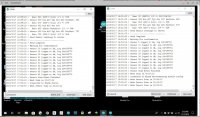- Thread starter
- #21
I switch over from a 300 Watt CMH to a HLG 100 v2. I can confirm with my light sensor that it is 2/3 the light output. The description of the HLG 100 v2 says it is equivalent to a 200 Watt CMH. Temperatures are way down, as expected, so that is good.
After a reboot of the arduino the outdoor sensor is back online. I realized that it is kind of a pain to debug one arduino with tons of pins set up. I can't debug it in the attic so bringing it down is time consuming. I'm thinking of changing directions from one mega arduino with long cable runs to multiple smaller arduinos.
After a reboot of the arduino the outdoor sensor is back online. I realized that it is kind of a pain to debug one arduino with tons of pins set up. I can't debug it in the attic so bringing it down is time consuming. I'm thinking of changing directions from one mega arduino with long cable runs to multiple smaller arduinos.




